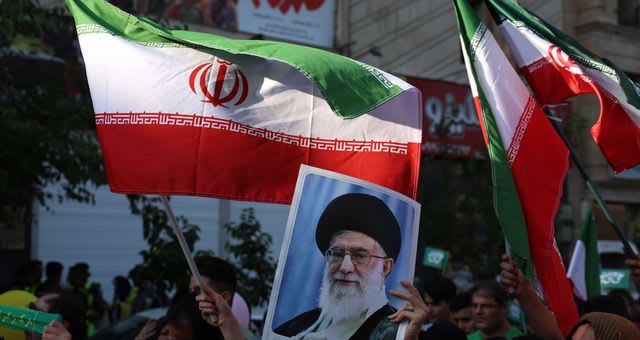Iran's Islamic Republic faces mounting existential pressures from economic collapse, sustained domestic protests, and military losses, but the regime's coercive apparatus remains intact and capable of maintaining power in the near term.
The Revolutionary Guard Corps (IRGC) continues to serve as the regime's primary survival mechanism, with enhanced control over succession planning and domestic security despite recent leadership losses.
While opposition voices claim the regime's grip is "weakening day by day," structural collapse remains unlikely without significant external intervention or IRGC fragmentation.
Economic crisis indicators suggest the regime faces its most severe domestic legitimacy challenge since 1979, with inflation projected above 35% and widespread labor unrest.
Iran's Islamic Republic confronts an unprecedented convergence of internal and external pressures that collectively pose the most serious threat to regime survival since the 1979 revolution. However, the regime's sophisticated coercive infrastructure and institutional adaptability continue to provide significant resilience against collapse scenarios (Dehghan, 2025). The economic foundations underpinning regime legitimacy are experiencing severe deterioration, with inflation projected to remain above 35% in 2025 under optimistic scenarios, while pessimistic forecasts suggest it could surpass 50% (Iran International, 2025). This economic crisis has triggered sustained labor unrest across multiple sectors, with doctors and pharmacists in Yasuj, Isfahan, and Ahvaz protesting over 18 months of unpaid wages, while broader grievances include soaring prices, excessive taxation, and economic instability.
The protest movement demonstrates remarkable persistence and broad geographic spread, with 216 demonstrations recorded in February 2025 alone, followed by significant nationwide protests on June 8, 2025, as citizens from diverse backgrounds took to the streets across numerous cities (Radio Farda, 2025). These protests represent broad-based dissatisfaction spanning professional, working-class, and retiree demographics, suggesting systemic rather than sectoral grievances. Exiled Iranian opposition groups characterize the regime's grip on power as "weakening day by day," though this assessment may reflect wishful thinking rather than objective analysis of regime capabilities (Iran International, 2025).
Despite facing military losses from Israeli strikes, the Islamic Revolutionary Guard Corps remains the regime's most critical survival asset. Regional experts expect the IRGC to play a pivotal role in selecting a successor to the aging Supreme Leader Ayatollah Ali Khamenei, which could further consolidate the organization's power beyond its current extensive influence (Middle East Institute, 2025). The IRGC's economic penetration provides additional regime stability, as the corps has enriched itself with billions of dollars by running illicit commercial and financial networks around international sanctions. The organization's institutional depth was demonstrated by the regime's ability to rapidly replace senior military leadership following Israeli strikes, with Khamenei appointing Abdolrahim Mousavi to replace Bagheri as chief of staff of the armed forces and Ahmad Vahidi to take Salami's position as IRGC commander, indicating organizational continuity despite tactical setbacks.
The regime's most significant structural weakness lies in Supreme Leader succession planning. Khamenei, at 86 years old, has ruled since 1989 and holds ultimate authority over all branches of government, the military, and the judiciary. His uncertain health and the prospect of a destabilizing succession process represents a critical vulnerability that could provide opportunities for regime change if managed poorly (Reuters, 2025). However, the IRGC's enhanced role in succession planning may actually strengthen regime continuity rather than create opportunities for democratic transition.
While Iranian opposition groups based in Iraq claim readiness to help build a new Iran, external opposition groups lack the domestic organizational capacity necessary to capitalize on internal dissatisfaction. The regime's security apparatus continues to prevent the formation of sustained opposition coordination mechanisms within Iran, limiting the potential for organized resistance movements to emerge. Recent Israeli military actions have created additional regime stress but are unlikely to trigger immediate collapse. Although Israel claims its attacks on Iran could topple the regime, experts assess this as unlikely, though the strikes could potentially shorten the lifespan of the theocratic government (Associated Press, 2025). The strikes eliminated key military leadership but have not fundamentally altered the regime's domestic control mechanisms.
The regime will likely survive current pressures through increased repression and IRGC mobilization in the near term of 6-12 months. Economic protests will continue but remain fragmented without coordinated leadership, while the succession question will become increasingly critical as Khamenei's health deteriorates. Medium-term risks over 1-3 years include the potential for regime change if external factors align with the combination of economic collapse and succession uncertainty. However, the IRGC's institutional strength and willingness to employ lethal force make peaceful transition unlikely. Regime collapse would most likely result from IRGC fragmentation during a succession crisis, combined with sustained economic collapse and external military pressure. Current conditions suggest increased instability but not imminent collapse without significant external intervention or internal security apparatus breakdown. The Iranian regime faces its most serious survival challenge since 1979, but its coercive capabilities and institutional adaptability continue to provide substantial resilience against immediate collapse scenarios. The next 12-18 months will likely determine whether current pressures evolve into existential threats or manageable challenges.

